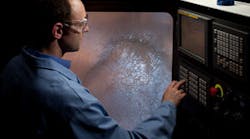At General Electric Aviation's manufacturing facility in Hookset, N.H., a new “superfast” technology has been developed for machining nickel-based superalloys used in aerospace components. The patented system cuts precision components like engine blisks three times faster than conventional milling techniques, according to GE Global Research, and requires 25% less electrical energy in the production process.
GE Global Research is in Niskayuna, N.Y., is the research and development center for all of GE's businesses. By taking on the task of producing higher quality metal parts faster and more efficiently, scientists and engineers there claim to have developed the “Superman” of machining technologies. It is a thermal cutting process called Blue Arc™, and according to one researcher there it has “given our manufacturing processes newfound superpowers.”
“This has been especially useful in aviation,” continued Andy Trimmer, a chemical engineer in the Process Systems Lab at GE Global Research, “where we’ve been able to reduce the machining of aircraft engine blisks from days to just hours.“
Blisks are specially designed rotating parts with dozens of blades on the edge. They form part of the engine’s compressor section, and similar components in specialty engineering alloys are needed for power-generation engines — another market where GE has a significant manufacturing presence.
The design and manufacturing efforts involved to produce a jet engine or a +400-MW power generation turbine are as impressive as the finished products. Producing them often demands machining off several tons of metal into very precisely designed components. Blue Arc can reduce the machining time and cost considerably.
“In addition to saving time, Blue Arc saves electricity,” Trimmer continued. “BlueArc requires lower force to achieve high material removal rates compared to conventional machining. Since the equipment does not need to be as heavy-duty to withstand the machining forces, the motors used to drive the axes are smaller and use less energy. Being able to save time and tooling costs is one thing. But when you also can reduce plant energy usage, this achieves the trifecta of best-in-class manufacturing.”
BlueArc is an electrical discharge machining process adapted to “hog out” large volumes of material. Typically, aerospace alloys are difficult to machine and have material properties that are similar to the cutting tool’s properties, which shortens cutting tool life significantly. In conventional milling, the tool must have a higher hardness than the workpiece material so chips can be produced. As material properties approach that of the cutting tool, milling has to slow down to preserve tool life and prevent breakage, and this increases production cost.
Because the material removal mechanism is electro-thermal rather than mechanical, the process is not affected by the material properties of the workpiece. This means low-cost electrodes can be used rather than carbide tools. The material is submerged to help cool it and shield the arc discharge. High-pressure flushing is used to evacuate chips from the cutting zone.
GE’s Blue Arc thermal cutting process has been adopted by GE Aviation as a roughing step in the manufacturing of blisks for its commercial aircraft engines. In a subsequent step, the thermal artifacts are removed by conventional machining.
Now, GE is exploring licensing opportunities for BlueArc, with machine builders and OEMs who would deploy as a roughing process for other operations, It predicts similar benefits from reductions in machining cycle time; lower tooling costs, and the opportunity to implement lean manufacturing concepts.








